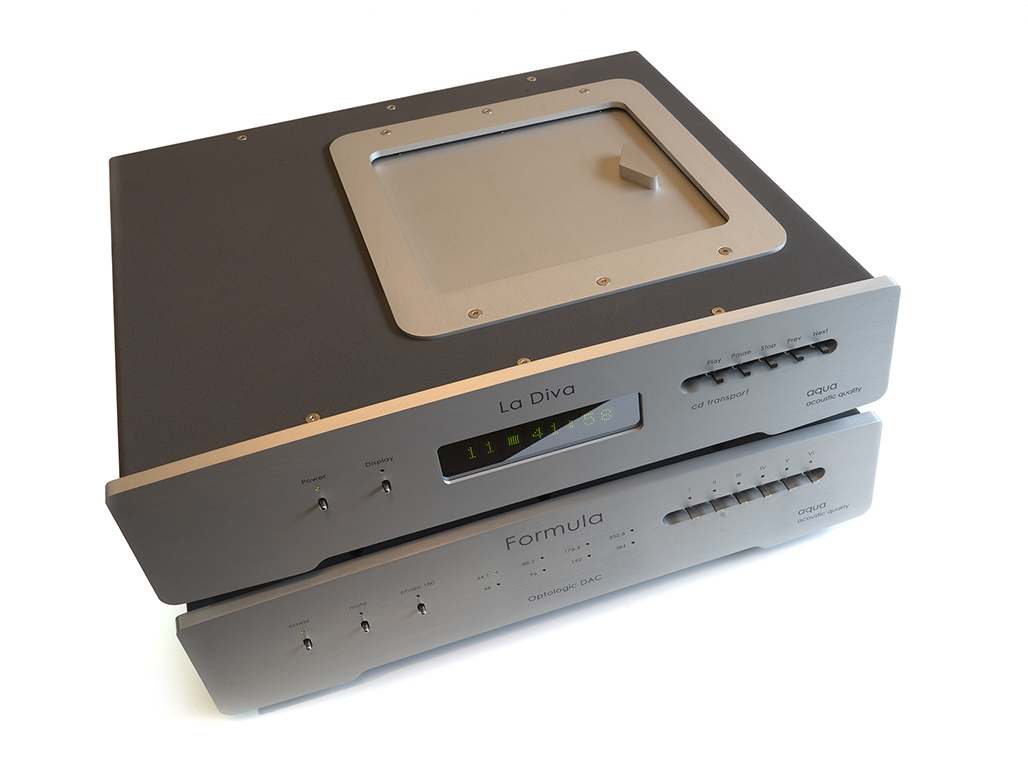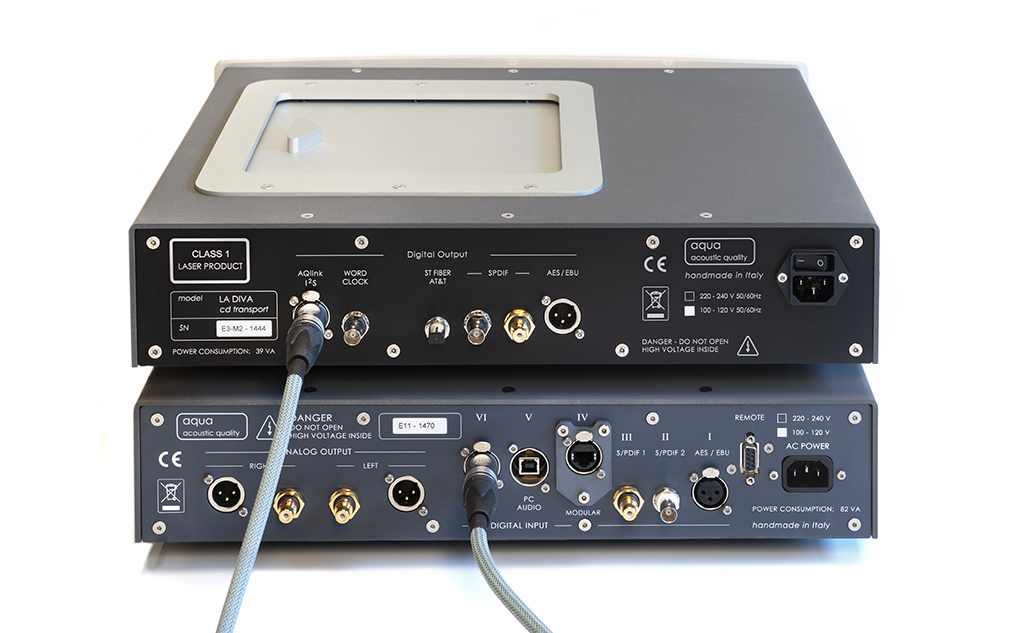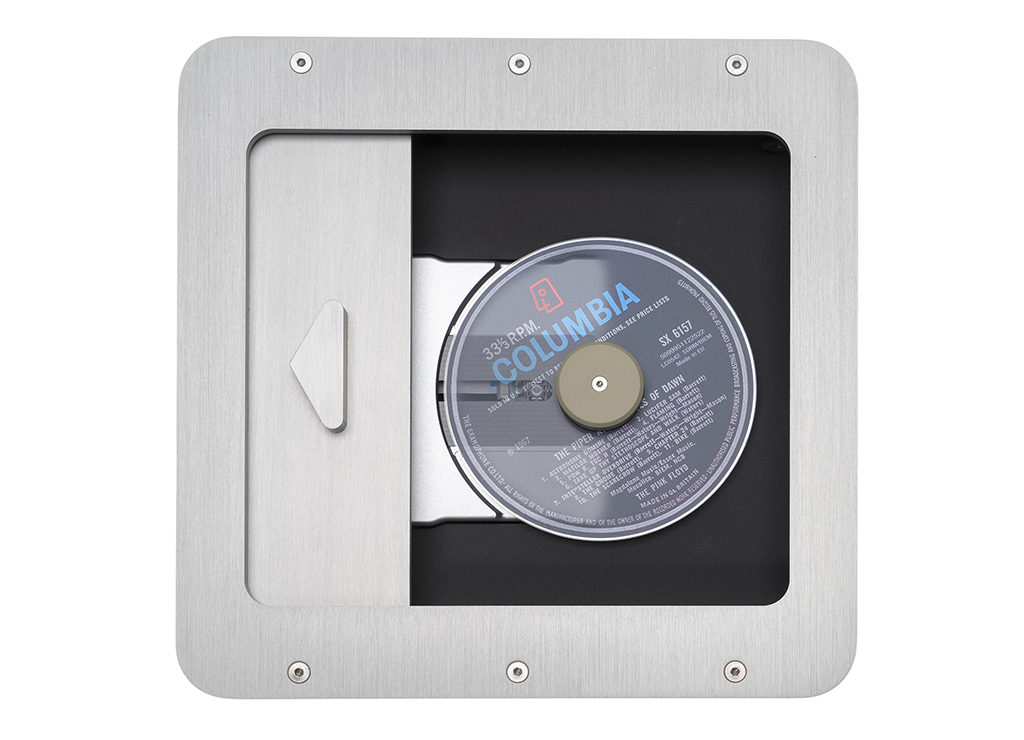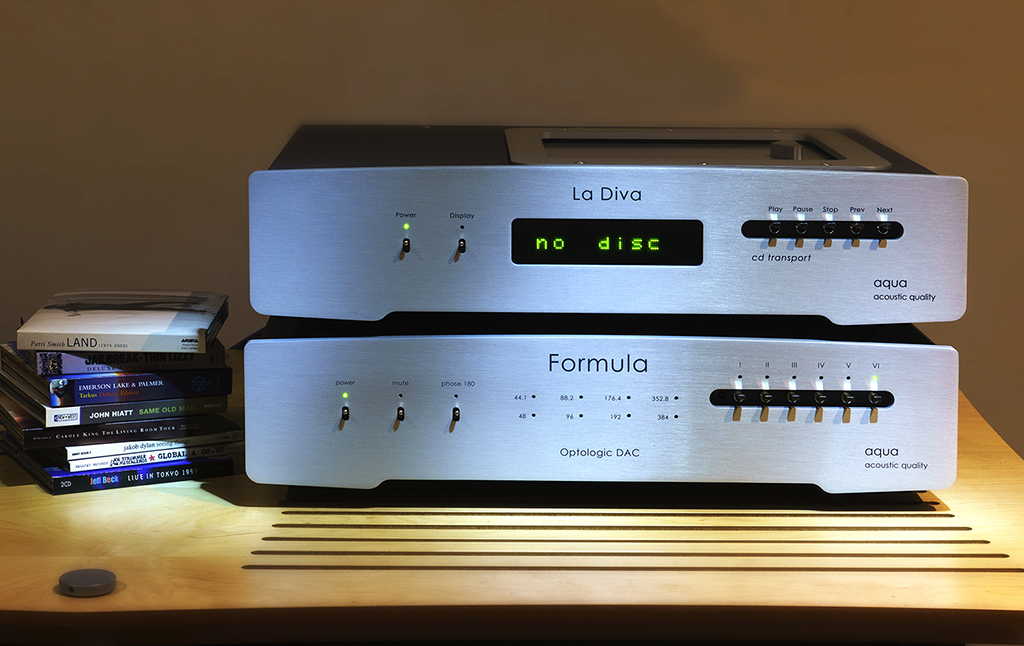The Formula xHD DAC (rev.2) and La Diva Transport An Amazing Duo From Aqua
By Jeff Dorgay
It seems appropriate to begin listening to the Aqua combination with Emerson, Lake, and Palmer’s “Still, You Turn Me On..” Even though the compact disc format was less than immersive when introduced back
in the early 80s, it has been transformed over the years.
Personally, I abandoned the “digital sucks”posture around 1990, and things have only gotten better and better to the point where digital audio is just fine. After all these years, I enjoy the compact disc more than ever, because I submit it’s the easiest format to listen to an album.
You might be squealing like a pig hearing those words, but consider this – a great CD player needs no setup. Depending on the table, arm, cartridge, and phonostage at your disposal, you could be driven to madness getting your analog front end set up to your satisfaction. Best of all, for most albums (by that, I mean a single record album) one only needs to push the play button, relax and enjoy it. For all the talk of “hearing the performance in the sequence the artist intended,” what’s better than hearing it all the way through, without getting up to flip the record over? That’s what I’m talking about.
Here’s another thought to ponder. Most CDs don’t always have as many variations on the mastering theme as vinyl records do. Hard core vinylistas know there can be a massive difference in sound quality between an A1 first stamper this or that and an average pressing. More often than not, said pressings can be incredibly expensive. Best of the best CD’s still don’t bring the cost premium that records do. Considering that a lot of unobtanium pressings run $300 – $1,000 these days, and people are still paying $2,500 for a MoFi One Step copy of Santana’s Abraxas, $9,600 for the LaDiva and $17,500 for the Formula xHD is by no means crazy money. With all eyes on vinyl these days, there’s some great deals in crate digging for CDs today.
Another aspect of the Aqua pair’s awesomeness is that now you don’t have to choose between a great analog or a great digital front end – from a cost or a sonic standpoint. I know this doesn’t address everyone, but if you are building a $100k – $200k system with great analog and digital sources, this makes perfect sense.
A DAC with a unique approach
Where so many DACs utilize whatever chipset is popular these days, Aqua takes the path of a very select few manufacturers that use an FPGA (field programmable gate array) and a resistor ladder to decode the digital signals. This requires a lot more attention to detail, because the resistor ladders need to be trimmed to tight tolerance, and the decoding is done in software.
The upside is twofold: arguably better, more natural sound, and a longer product lifespan because when improvements are made, a firmware update is all that’s needed. It’s nice to know when you’re spending close to 20 thousand dollars on a DAC, that you can expect a long service life with a solid upgrade path.
Where the LaScala DAC uses vacuum tubes in the circuit, the Formula xHD is all solid-state. The voicing between the two units is more similar than not. It only took about 24 hours of continuous play to feel the big Aqua DAC to go from about 90% to 100%, so this isn’t a DAC you’ll need to spend hundreds of hours “breaking in.”

Ins and outs
The Formula has a pair of single ended RCA and balanced XLR outputs on the rear panel. The balanced outputs are transformer coupled, and when comparing back and forth with the Pass XS Pre, there is a slight but noticeable difference between the two. As you might expect, the balanced outs have a bit more tonal saturation and warmth. I’ve had the same experience with other sources that deliver a balanced output with transformers. When using the CJ GAT 2 preamplifier, that only has RCA connections, this was a welcome addition, making the Formula compatible with a wider range of systems.
With six digital inputs, the Formula is the perfect hub for all things digital. It features an ABS/EBU port, and two S/PDIF inputs – one for coax RCA cables and the other for BNC. A galvanically isolated USB is perfect for those streaming via computer, and an I2S input, should you be using Aqua’s LaDiva transport or their LinQ server. Aqua offers their own AQlink-Pro cable for $510, which they supplied for this review to link the two boxes together.
The fourth input of the six is labeled “modular,” and in this case is an additional I2S input. However, you can have this configured for any kind of digital input (including Toslink) to further accommodate your needs. You never know, someone might come up with a new digital connector! Combining this with the ability to update the FPGA and this makes for a DAC you can live with for a long time.
Just music
We’ve had a number of great DACs over the last 20 years, both as review pieces and as personal references. Going back and forth between the AQUA pair and the dCS Vivaldi is incredibly interesting. We don’t typically do “shootout” reviews, and we won’t start, however, with digital, it’s a lot easier to compare back and forth between two components because it’s easier to keep things perfectly equal. Comparing different turntables requires both tables having the same cartridge, exact duplicates of the same record, and both tables set up not only to perfection, but to each other. Anything less isn’t fair to the comparison.
To put things in proper perspective, I own the $9,000 AQUA LaScala DAC and the $95,000 dCS Vivaldi ONE/Apex. My Vivaldi is back at dCS being updated, but we did have the Apex version here while the Formula xHD was here. It was a ton of fun to compare the Aqua, the Formula xHD, the Vivaldi ONE and the Apex version on a wide range of source material. This is by no means an apples to apples comparison, because the dCS does play SACD (though I maybe have 100 SACD’s in my collection, so it’s not a deal breaker) It’s truly not a “better than” thing. The Aqua sounds more analog-y and the dCS more analytical. Which phono cartridge do you like better, a Lyra Etna or a Koetsu Jade? If you are more towards the Koetsu, I think you’d prefer the Aqua combination. Would you rather have a pair of Focal Grande Utopia EMs, or a pair of Sonus Faber Aidas? If you’d rather have the Focals, you might like the dCS better. Also, I’m sure you will have to consider the overall tonal balance of your current system.
However, the Aqua gives no quarter to the big dCS in terms of detail retrieval from CD and streaming files. The only thing it does not offer is an input for an external word clock. Again no deal breaker – and adding this to the dCS puts it in six-figure territory. Not a fair comparison. It was a pleasure to listen to so much truly engaging digital hardware, and for the price asked, there’s nothing I’ve heard that is near as musically engaging as the Aqua Formula xHD/La Diva combination for playing CDs.
The Aqua pair reminds me so much of my Naim CD555/PS555 combination, and that was $33,000 over a decade ago. There are some noted similarities – this is optimized for CD playback only, features major electrical and physical separation of the various analog and digital sections, with superb attention paid to power supply implementation. Where the CD555 used a chipset for digital decoding and the Aqua a FPGA, they both agreed on no upsampling to achieve results. I have to think that in this case, great minds think somewhat alike.
And again, to be transparent, I prefer an overall tonality that is just slightly to the warm/romantic/saturated side of neutral. So, if that’s your cup of, this pair will be tremendously satisfying.
It’s also worth mentioning, that when comparing the two Aqua DACs, they have enough sonic similarity, that you know they are both designed in the same house, the Formula delivers substantially more dynamic impact, subtle detail retrieval, and extension on both ends of the frequency range. Spending nearly twice as much brings a lot more music. Think of it as the difference between a basic 911 Carrera and a heavily optioned 911 GTS. The Formula is not a case of diminishing returns.
Spinning disc or streaming bits?

The Aqua delivers digital sound so truthfully, it’s hard to believe you aren’t listening to analog and that’s the highest compliment I can pay. During the Formulas time here, a number of audio enthusiast friends and even a few manufacturers came away highly enthused with the presentation of the Aqua pair.
And exactly like the players we’ve used from dCS, Esoteric, and PS Audio, I still prefer the sound of a disc or file ripped from an original CD to that of a file streamed from Tidal or Qobuz – even when they are 24/192 files. At the level of resolution, the Aqua DAC delivers, graininess and a more digital sound creeps into the presentation when comparing the disc to streamed audio. If you listen carefully, it’s not subtle.
Because the LaDiva M2 transport plays only CDs, you might think there isn’t much to discuss, other than the fact it does its job incredibly well. Like a Formula 1 car, everything has been optimized to deliver as much as the CD is capable of delivering. Those who ignore the redbook CD, do so at their own peril – when you hear CD’s rendered by the Aqua transport, it’s a completely different movie. And the deeper you dig, you see nothing has been left to chance here with this transport.
Aqua’s founder, Cristian Anelli says “The reading mechanism used is designed and optimized solely for reading CDs and nothing else. The modified StreamUnlimited CD Pro-8S transport implements the latest and most advanced Philips CD decoding circuit – with digital servo control – to our proprietary Aqua electronics.” That’s not the whole story. Aqua has disabled the internal master clock of the transport, managing it with another FPGA. Everything that can be optimized has been.
Thanks to the top loading design (with a billet machined sliding door) you’ll never need to worry about a drawer mechanism jamming, or malfunctioning. Merely put the CD in, install the weight/stabilizer, shut the door and push play. Fantastic. If you don’t think a transport makes a difference, and “bits are bits,” plug your favorite $500 CD player into the back of the Aqua DAC and compare. Prepare to be floored. Just like in analog, everything matters.
A quick peek at the back panel shows outputs for their own AQlink (I2S) bus, which I’ve never seen with a CD transport, along with toslink(AT&T ST Fiber) coax and BNC SPDIF, and AES/EBU. So even if you don’t have an Aqua DAC, you might consider stepping up to the LaDiva 2 to use with whatever DAC you currently own.

A deserving winner
In the end, Aqua’s top DAC and new transport offer a fantastic combination of digital playback. If you already have a streamer, merely plug it in, or use Aqua’s excellent LinQ. Should you only desire disc playback, these two are all you need. I certainly feel like a lucky man having the opportunity to sample these, and I’m budgeting for a La Diva M2 of my own next year to go along with the La Scala MK II in system two.
If you don’t need SACD, Blu-Ray, or DVD-a playback, this combination is one of the world’s finest offerings. All of the Aqua pieces are built to a fanatical standard and offer a top-level aesthetic as well. And you thought Italy just produced cool cars and motorbikes! Highly recommended.
originally reviewed in Dec 2022, the Aqua combo was our digital product of the year. -ed.
https://www.aquahifi.com/formula.html
Peripherals
Preamplifier Pass Labs XS Pre
Power Amplifiers Pass Labs XA200.8 monoblocks
Speakers Sonus faber Stradiveri’s, six REL no.25 subwoofers
Cable Cardas Clear


